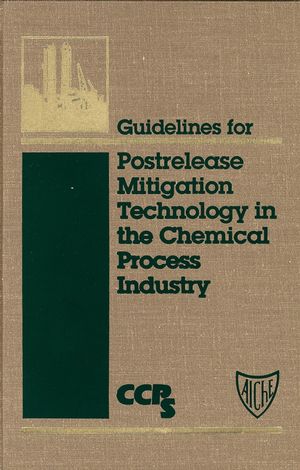Guidelines for Postrelease Mitigation Technology in the Chemical Process IndustryISBN: 978-0-8169-0588-1
Hardcover
192 pages
December 1996
 This is a Print-on-Demand title. It will be printed specifically to fill your order. Please allow an additional 10-15 days delivery time. The book is not returnable.
|
||||||
1.1. Introduction.
1.2. Scope of This Book.
1.3. Benefits of Postrelease mitigation Techniques.
1.4. How to Use This Guideline.
1.5. Guideline Organization and Content.
1.6. References.
Chapter 2. Overview of release Scenarios and Post release. Mitigation.
2.1. Introduction.
2.2. Mitigation Categories.
2.3. Prerelease Mitigation Techniques.
2.3.1. Inherently Safer Design.
2.3.2. Physical Integrity of a Plant.
2.3.3. Process Integrity.
2.3.4. Emergency Relief Treatment Systems.
2.3.5. Emergency Process Abort Systems.
2.3.6. Emergency Isolation of Releases.
2.4. Release Scenarios and Consequences.
2.4.1. Types of Releases.
2.4.2. Liquid Releases.
2.4.3. Liquid Pool Formation.
2.4.4. Flashing, Mixed Liquid-Vapor Releases.
2.4.5. Behavior of Flashing, Mixed Liquid-Vapor Releases.
2.4.6. Gases/Vapors.
2.5. Consequences of a release.
2.5.1. Nature of Hazards.
2.5.2. Toxic and Flammable Dispersion.
2.5.3. Thermal Radiation.
2.5.4. Explosions.
2.5.5. Explosion Hazards.
2.6. Postrelease Mitigation Techniques.
2.6.1. Containment or Suppression to Limit Releases to the Air.
2.6.2. Countermeasures.
2.7. References.
3. Vaporization Reduction.
3.1. Introduction.
3.1.1. Why Reduce Vaporization Rates?
3.1.2. Methodology.
3.2. Refrigeration.
3.2.1. Effect of Refrigeration on Vaporization Rates.
3.2.2. System Issues.
3.2.3. Reactive Materials.
3.3. Covers.
3.3.1. Vapor Suppression Foams.
3.3.2. Dry Chemical Covers.
3.3.3. Other Covering Techniques.
3.4. Deliberate Ignition.
3.5. References.
Chapter 4. Fluid Curtains.
4.1. Introduction.
4.2. Previous Work.
4.3. Absorption/Mass Transfer.
4.4. Air Dilution.
4.5. Defining Spray Requirements for Mitigation.
4.5.1. Water Curtain Design Example.
4.5.2. Spray Nozzles.
4.5.3. Water Supply Capacity, Pressurization, and Reliability.
4.5.4. Fixed Water-Spray Systems.
4.5.5. Monitor Nozzle and Hydrant Protection.
4.5.6. Environmental Considerations.
4.6. Vapor-Phase Dilution Systems.
4.6.1. Overview.
4.6.2. Steam Curtains.
4.6.3. Air Curtains.
4.6.4. Foam Scrubbing.
4.6.5. Dry Powder Curtains.
4.7. References.
5. Secondary Containment.
5.1. Introduction.
5.2. Diking.
5.2.1. Optimal Dike Geometry.
5.2.2. Materials for Dike Construction.
5.2.3. Provisions for Removal of Materials From a Dike.
5.2.4. Regulatory Requirements Regarding Diking.
5.2.5. Emergency Response Dikes.
5.3. Double-Wall Containment.
5.4. Enclosures.
5.5. Transfer Vessels.
5.6. Leak Plugging.
5.6.1. Patching.
5.6.2. Freezing.
5.7. Physical Vapor Barriers.
5.7.1. Overview.
5.7.2. Vapor Fences.
5.7.3. Vapor Boxes.
5.7.4. Applicability of Vapor Barrier Devices.
5.7.5. Effects of Process Equipment and Structures.
5.8. References.
Chapter 6. Detection and Response.
6.1. Introduction.
6.2. Leak Detection.
6.2.1. Fixed-Point Detectors.
6.2.2. Sampling Systems.
6.2.3. Portable Detectors.
6.2.4. Detector System Response Times.
6.2.5. Detector Placement.
6.2.6. System Reliability.
6.3. Emergency Response.
6.3.1. Introduction.
6.3.2. Fundamentals of a Comprehensive Emergency Response Plan.
6.3.3. Emergency Response Training.
6.4. Community Relationships and Interactions.
6.5. Drills and Simulations.
6.5.1. Table-Top Exercises.
6.5.2. Plant-Wide Emergency Drills.
6.5.3. Full-Scale Emergency Simulations.
6.6. Temporary Havens.
6.6.1. Criteria for Use.
6.6.2. Design Criteria.
6.6.3. Capacity.
6.6.4. Communications and Other Equipment.
6.7. References.
Chapter 7. Examples of Mitigation Effectiveness.
7.1. Introduction.
7.2. Consequence Modeling.
7.3. Basis for Examples.
7.4. Modeling Conditions.
7.5. Effect of Diking.
7.6. Use of Foam.
7.7. Mitigation by Refrigeration.
7.7.1. Pressure Storage of Ammonia.
7.7.2. Refrigerated/Ammonia Storage.
7.7.3. Refrigeration Combined with Diking.
7.8. Use of Water Sprays.
7.9. Mitigation System Selection.
7.10. References.



